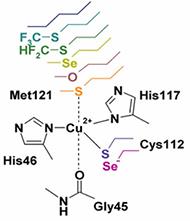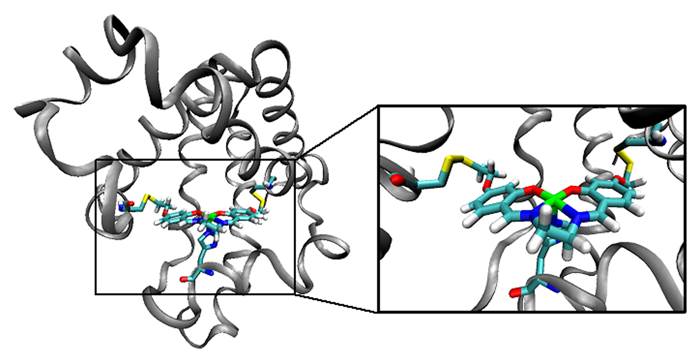Unnatural Amino Acids and Non-Native Cofactors
A closer look at native metalloproteins reveals that they use only a small sub-set of the ligands and metal-containing prosthetic groups synthesized by inorganic chemists. For example, there are only 20 natural amino acids, less than half of which are capable of coordinating to metal ions. Unnatural amino acids (UAAs) or non-native metal-containing cofactors greatly expand the range of chemical moieties and functionality of a single protein without grossly changing the overall structure of the system. The precise roles of key residues important to protein structure and function can be fine-tuned beyond what is found in nature. Using UAA incorporation, we replaced Tyr33 in our F33Y-CuBMb model with several Tyr analogues and showed the important role of the pKa and redox potential of the active site Tyr residue in tuning activity (1, 2).
We became the first lab to introduce unnatural amino acids into metalloproteins using a method called expressed protein ligation (EPL) (3-5). We have also contributed to the field, expanding the EPL method by, for example, developing protocols for using selenocysteine instead of cysteine as the coupling amino acid (3, 6). Isosteric substitutions using UAAs enabled us to resolve long-standing issues such as the role of conserved methionine and cysteine in blue copper azurin (3, 8-11) (Figure 1). Recently, we expanded our ability to incorporate UAAs by using an orthologous tRNA-tRNA synthetase pair. Using this method an UAA was incorporated into CuBMb (our HCO model) that mimics the native HCO His-Tyr crosslink. Introduction of this crosslink increased the rate and efficiency of the reaction significantly (12).


One of the greatest challenges faced by today’s synthetic chemists is the search for ways to carry out asymmetrical chemical syntheses in an environmentally benign way. To address this challenge, we have developed a novel dual-anchor approach to introduce non-native cofactors such as Mn(Salen) (13) (see Figure 2) or metallocenes (14) into proteins to produce novel biocatalysts with unprecedented structural and functional properties through the combination of the high catalytic reactivity of metal complexes with the rigid and chiral protein environment. In addition, through systematic variation of the protein environment around both the metal- and substrate-binding sites, we can tailor reactivity and regio-, stereo-, and enantio-selectivity with high precision (4, 15-17).
- Yu, Y., et al. Chemical Science. 2015, 6, 3881-3885.
- Yu, Y., et al. J. Am. Chem. Soc. 2015, 137, 4594-4597.
- Berry, S. M., et al. J. Am. Chem. Soc. 2002, 124, 2084-2085.
- Lu, Y. Curr. Opin. Chem. Biol. 2005, 9, 118-126.
- Lu, Y. Angew. Chem. Int. Ed. 2006, 45, 5588-5601.
- Clark, K. M., van der Donk, W., and Lu, Y. Methods Enzymol. 2009, 462, 97-115.
- Berry, S. M., et al. J. Am. Chem. Soc. 2003, 125, 8760-8768.
- Garner, D. K., et al. J. Am. Chem. Soc. 2006, 128, 15608-15617.
- Sarangi, R., et al. J. Am. Chem. Soc. 2008, 130, 3866-3877.
- Clark, K. M., et al. J. Am. Chem. Soc. 2010, 132, 10093-10101.
- Liu, X., et al. Angewandte Chemie International Edition 2012, 51, 4312-4316
- Clark, K.M., et al. Inorg. Chem. Frontiers 2014, 1 (2) 153-158
- Zhang, J.-L., et al. Chem. Eur. J. 2009, 15 (30), 7481-7489.
- Zhang, J.-L., et al. Chem. Comm. 2008, 1665-1667.
- Hwang, H. J., et al. J. Am. Chem. Soc. 2005, 127, 15356-15357.
- Carey, J. R., et al. J. Am. Chem. Soc. 2004, 126, 10812-10813
- Dewain K. Garner, Lei Liang, David A. Barrios, Jun-Long Zhang, Yi Lu, ACS Catalysis. 2011, 1, 1083-1089.